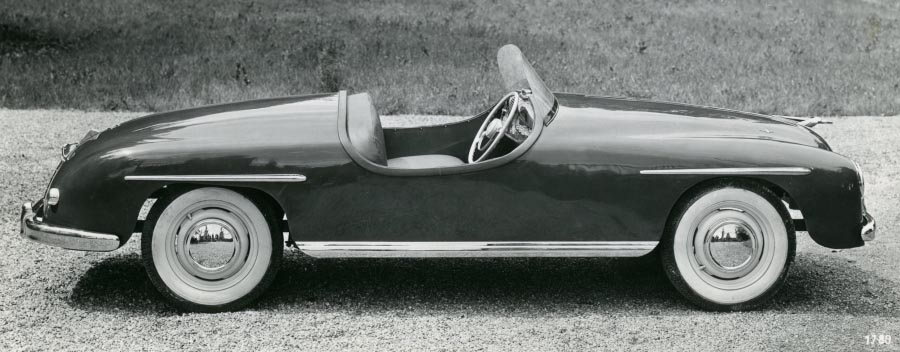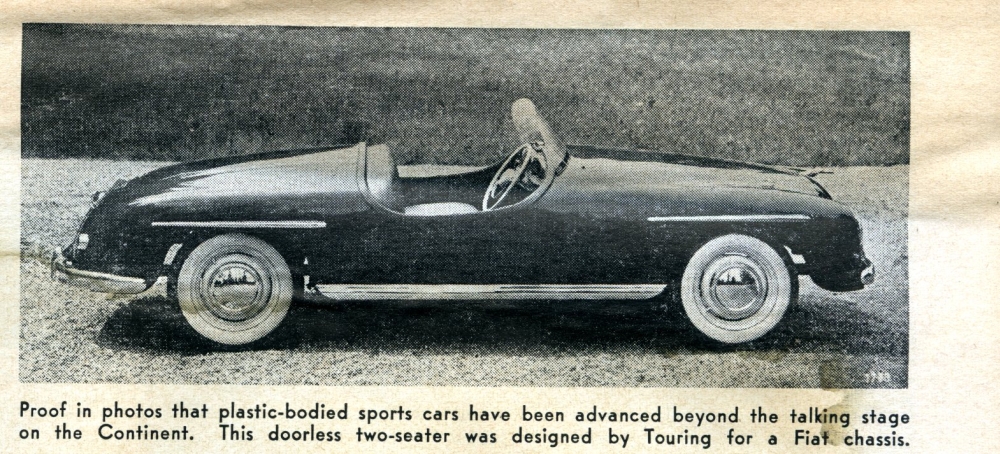
Hi Gang…
I’ve been researching this car for quite some time, and recently came across a beautiful hi-res photo of the car from back in 1953. It was an experimental car – a prototype – designed by La Carrozzeria Touring for the Italian chemical company Montecatini. If it had a name, I have yet to find it, so I’ve always called it the “Montecatini.”
Let’s see what they had to say about this car back in the 1954 Trend Book titled “Manual of Building Plastic Cars.”
Manual of Building Plastic Cars: 1954
An Italian chemical concern, in order to boost interest among car manufacturers, built a plastic sports car which was exhibited in April of 1953 at the Milan Chemical Show. This car was designed by the Italian firm of Carozzeria Touring and used a Ferrari chassis and engine.
It is an open sports car, seating three people. Montecatini claims that one of the difficulties in the construction of a polyester car body lies in such external parts as door hinges, as well as the doors themselves, which usually weaken the plastic shell unduly. The body was constructed by Montecatini on the Ferrari chassis, consequently, is doorless, using lowered sections at the side of the seat for access.
This car has attracted considerable attention in Europe, considering that it is larger than the very popular Dyna-Panhard chassis. The car is about the same size as the Wildfire.
A plastic bodied Ferrari in 1953? Why haven’t we heard of this before? Probably because….it wasn’t a Ferrari. Two later “finds” confirm that the chassis was most likely an 1100 Fiat and not a Ferrari – as follows:
Road & Track: February, 1954
Proof in photos that plastic-bodied sports cars have been advanced beyond the talking stage on the Continent. This doorless two-seater was designed by Touring for a Fiat chassis.
John Bond Archives: Kettering University
And…in a recent trip to the John Bond Archives at Kettering University in Flint, Michigan, we found the following high-res photo and caption:
The first Italian plastic body built by Touring. The material is called “Poliestere” made by Montecatini Company. The body weighs 90 lbs (on a) 1100 Fiat Chassis.
Summary:
The use of fiberglass was NOT a uniquely American experience.
I’ve written about the first documented fiberglass car built in the UK in 1954 – The Allard Clipper. France’s first fiberglass car designed and built by Luigi Colani in 1953, and the first fiberglass car built in Germany in 1955 by Spohn. We’ve even showcased a mystery fiberglass car shown in Czechoslavkia from 1956 and a 1948 VW fiberglass prototype too.
As we’ve said here before, “fiberglass” was the “carbon-fiber” composite of its’ day. Companies built prototypes with this new wonder material and people flocked to shows to see these cars – just as they do with their carbon-fiber composite brothers.
So where is the “Montecatini” sports car today? I’ve poked and prodded a bit but haven’t found it yet. Perhaps one of our European fiber-aficionados will join us in the hunt and help us discover the rest of the story
Hope you enjoyed the story, and remember gang…
The adventure continues here at Forgotten Fiberglass.
Geoff






Great article on a very obscure vehicle. Thanks for the photos. They prove that back in the 50s, fiberglass and plastic vehicles didn’t have to look boxy or ugly. This car has a design that is timeless. Too bad it was never in production.
Scot, Robert….thanks for the kind words and glad you enjoyed the post. Good friend Paul Jaray/Francesco posted additional information an this car with a different name on Facebook. All info points to “Fiat” chassis/drivetrain. Here’s the link to review:
https://www.facebook.com/groups/1518975768323381/permalink/1596018283952462/
Hope you enjoy
Geoff
great story geoff. keep this way in 2015 – carpe viam. r nasser
~ Thanks for another eye-opener, Geoff. Do you have any theories as to the Ferrari/Fiat confusion?
What comes to mind for me is that the Hudson Italia project would have begun concurrently with this fiberglass body. The Italia, with all of its complex forms was a natural for fiberglass but as produced in aluminum and hand finished with epoxy fillers added excessive costs to the car damaging its marketability. What if the Hudson Italia had been Touring’s NEXT fiberglass project? We won’t know.
Hi Geoff, You have really excelled here. I was doubting for a minute but the car does seem to have the Carrozzeria Touring badge in their usual place on the bonnet.
Great story Geoff – about another car that I’ve never seen before!